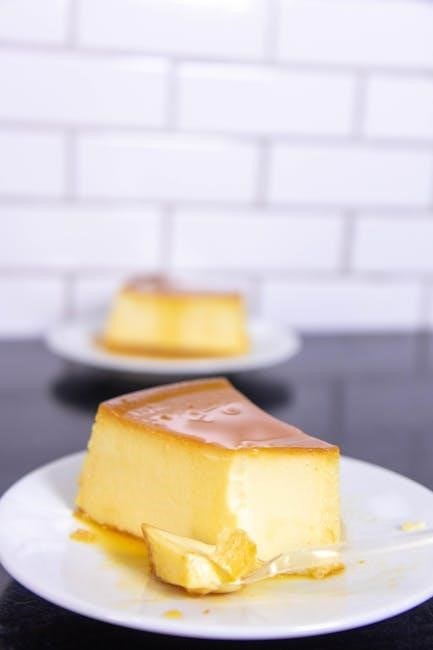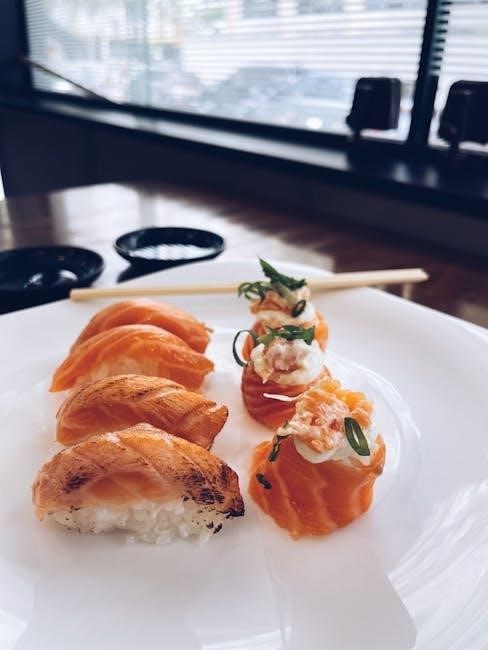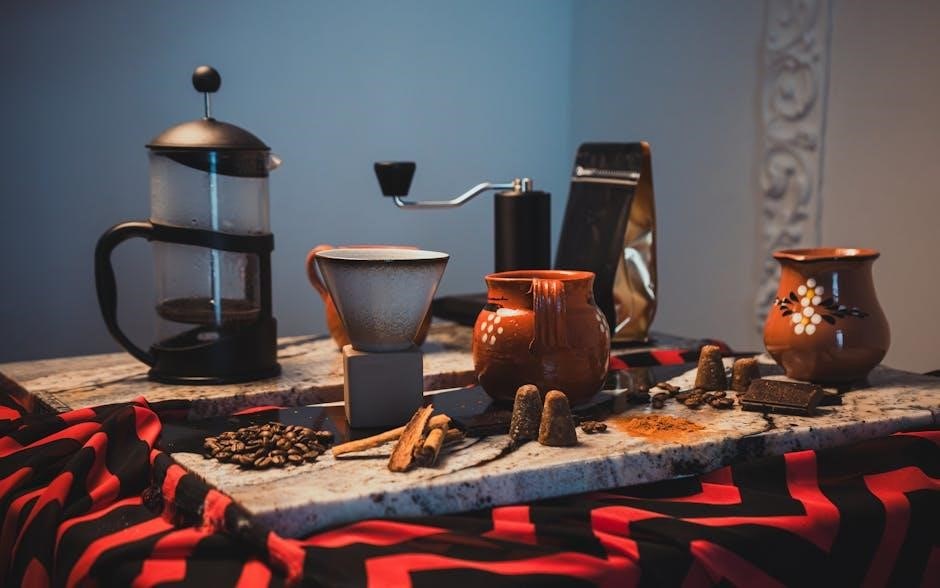Modernist Cuisine, a groundbreaking culinary movement, combines science and creativity to transform cooking. Pioneered by Nathan Myhrvold, Chris Young, and Maxime Bilet, it introduces innovative techniques like sous vide and spherification, blending art and chemistry to redefine traditional recipes and elevate home cooking to new heights.

Overview of Modernist Cuisine
Modernist Cuisine is a culinary movement that merges science, creativity, and tradition to revolutionize cooking. It emphasizes understanding the chemical and physical transformations in ingredients, enabling chefs to innovate and refine techniques. Pioneered by Nathan Myhrvold, Chris Young, and Maxime Bilet, it introduces methods like sous vide, spherification, and foaming, transforming traditional dishes into futuristic culinary experiences. This approach democratizes high-end cooking, making it accessible to home cooks through detailed guides and tools, while maintaining a focus on flavor, texture, and presentation. Modernist Cuisine bridges the gap between science and art, redefining the possibilities of food preparation.
Historical Context and Evolution
Modernist Cuisine traces its roots to the early 20th century, evolving from molecular gastronomy and scientific cooking experiments. Chefs like Heston Blumenthal pioneered these techniques, while Nathan Myhrvold and Chris Young formalized them in their 2011 magnum opus, Modernist Cuisine: The Art and Science of Cooking. This six-volume set revolutionized cooking by detailing scientific principles behind innovative methods. The movement gained momentum with the 2017 release of Modernist Bread, expanding its scope. Today, Modernist Cuisine continues to influence both professional kitchens and home cooks, offering a bridge between tradition and cutting-edge culinary innovation.

Key Techniques in Modernist Cuisine
Modernist Cuisine employs techniques like sous vide, spherification, foaming, gelling, and thickening to create innovative dishes, blending science and creativity for transformative culinary experiences.
Sous Vide Cooking
Sous vide is a cornerstone of Modernist Cuisine, involving food sealed in airtight bags and cooked in water baths at precise temperatures. This technique ensures uniform doneness, preserving flavors and textures. Restaurants and home cooks alike use it for dishes like eggs, meats, and vegetables. The immersion circulator regulates temperature with extreme accuracy, allowing for consistent results. Sous vide enhances food safety and reduces waste, making it a versatile and innovative method. Its popularity has grown due to its simplicity and the ability to achieve restaurant-quality meals at home, as detailed in Modernist Cuisine and Modernist Cuisine at Home.

Spherification and Gelling
Spherification and gelling are iconic Modernist techniques that transform liquids into unique textures. Spherification uses sodium alginate and calcium chloride to create caviar-like pearls, while gelling employs agar or pectin to set liquids into firm, jiggly, or flexible forms. These methods allow chefs to reimagine ingredients, such as encapsulating tomato water in basil oil or crafting vibrant, bite-sized flavor bursts. Gelling also enables the creation of fluid gels, adding visual and tactile intrigue to dishes. These techniques, detailed in Modernist Cuisine, push culinary boundaries, offering endless possibilities for artistic and scientific expression in both professional and home kitchens.
Foaming and Emulsification
Foaming and emulsification are key Modernist techniques that redefine texture and presentation. Foaming involves creating airy, flavorful mousse-like textures using ingredients like soy lecithin or whipping siphons. Emulsification stabilizes mixtures of oil and water, such as vinaigrettes, using stabilizers like lecithin or xanthan gum. These methods allow chefs to innovate, crafting light, ethereal foams or perfectly balanced sauces. Detailed in Modernist Cuisine, these techniques empower home cooks and professionals alike to experiment with novel textures, enhancing both visual appeal and flavor complexity in modern dishes. They exemplify the fusion of science and culinary artistry.
Thickening and Fluid Gels
Thickening and fluid gels are essential Modernist techniques that manipulate texture through hydrocolloids like agar, carrageenan, and pectin. These ingredients create stable, gel-like structures when heated or mixed with liquids. Fluid gels, formed by blending hot agar solutions, offer unique textures, such as slices or cubes, adding visual and tactile intrigue to dishes. Detailed in Modernist Cuisine, these methods allow chefs to innovate, crafting everything from delicate gelatinous bites to robust sauces. They exemplify how science transforms traditional cooking into artistic, modern culinary experiences, expanding creativity in both professional and home kitchens;
Modernist Ingredients

Xanthan gum, agar, and other hydrocolloids are cornerstone ingredients in Modernist Cuisine, enabling unique textures like gels, foams, and fluid gels, and revolutionizing traditional cooking techniques with scientific precision.
Xanthan Gum and Its Applications
Xanthan gum is a cornerstone ingredient in Modernist Cuisine, serving as a powerful thickening and stabilizing agent; Derived from the bacterium Xanthomonas campestris, it enhances texture in sauces, dressings, and batters without altering flavor. Unlike traditional thickeners, xanthan gum works across a wide temperature range, making it ideal for both hot and cold preparations. It prevents ice crystal formation in frozen dishes and creates smooth, even textures in emulsions. Chefs use it to achieve perfect consistency in modernist recipes, from silky mac and cheese to stable foams, showcasing its versatility in innovative cooking techniques. Its applications are vast, transforming traditional dishes into modern culinary masterpieces.
Agar and Other Hydrocolloids
Agar, a hydrocolloid derived from red algae, is a key ingredient in Modernist Cuisine, offering exceptional gelling properties. It creates firm, heat-stable gels ideal for dishes like jellies and terrines. Unlike gelatin, agar sets at room temperature and remains stable when reheated, making it versatile for both sweet and savory applications. Other hydrocolloids, such as carrageenan and pectin, also play roles in Modernist cooking, contributing to texture and stability in emulsions and fluid gels. These ingredients enable chefs to push culinary boundaries, blending science and creativity to craft innovative, visually stunning dishes that redefine traditional cooking techniques.

The Authors and Their Contributions
Nathan Myhrvold, Chris Young, and Maxime Bilet pioneered Modernist Cuisine, blending science and culinary art. Their collaborative work revolutionized cooking techniques, inspiring chefs and home cooks alike.
Nathan Myhrvold and His Vision
Nathan Myhrvold, a visionary scientist and former Microsoft CTO, co-authored Modernist Cuisine, revolutionizing cooking by merging science and culinary art. His passion for precision and innovation led to the creation of a comprehensive 2,438-page cookbook. Myhrvold’s work demystifies complex techniques like sous vide and spherification, making them accessible to home cooks. His vision emphasizes understanding the chemistry behind cooking, empowering chefs to experiment and innovate. The book’s detailed recipes and scientific insights have redefined modern cooking, inspiring a new generation of culinary enthusiasts.
Chris Young and Maxime Bilet
Chris Young and Maxime Bilet, alongside Nathan Myhrvold, were instrumental in shaping Modernist Cuisine. Young, a culinary researcher, and Bilet, a skilled chef, brought scientific rigor and creativity to the project. Their work at The Fat Duck and later at The Cooking Lab laid the foundation for the cookbook. They introduced techniques like sous vide and spherification, making them accessible to home cooks. Their collaborative vision transformed cooking into a science-driven art form, inspiring innovation in kitchens worldwide. Their contributions have left a lasting impact on modern culinary practices.
Modernist Cuisine at Home
Modernist Cuisine at Home revolutionizes cooking by adapting restaurant techniques for home cooks. This award-winning, 456-page guide offers innovative recipes and scientific insights, transforming everyday meals into extraordinary culinary experiences.
Adapting Restaurant Techniques for Home Cooks
Modernist Cuisine at Home bridges the gap between professional kitchens and home cooking, offering innovative techniques like sous vide and spherification. With tools such as immersion circulators and whipping siphons, home cooks can achieve restaurant-quality results. The book provides detailed guidance, simplifying complex methods and making them accessible. Recipes like pressure-cooked soups and silky mac and cheese showcase how science-driven cooking enhances flavor and texture. This approach empowers home cooks to experiment creatively, bringing modernist culinary art into their own kitchens with ease and precision.
Essential Tools and Equipment
Modernist Cuisine requires specialized tools to achieve its innovative results. Sous vide machines ensure precise temperature control, while whipping siphons create foams and emulsions. Immersion circulators, vacuum sealers, and precision thermometers are also crucial. Additionally, tools like ultrasonic homogenizers and dehydrators expand creative possibilities. These devices, often adapted from scientific and industrial contexts, enable home cooks to replicate restaurant-level techniques. The investment in such equipment allows for consistent experimentation and the exploration of new culinary frontiers, making Modernist Cuisine accessible beyond professional kitchens.

Modernist Bread
Modernist Bread, a five-volume comprehensive guide, explores the science, history, and techniques behind bread making, offering innovative recipes and insights for both professionals and home bakers.
Exploring the Science of Bread Making
Modernist Bread delves into the science behind bread making, examining yeast fermentation, gluten structure, and starch transformation. It reveals how ingredients like enzymes and salts influence dough behavior, offering insights into achieving perfect crumb and crust. The book provides a detailed exploration of bread’s chemical and physical processes, from ancient techniques to modern innovations. With extensive research and practical applications, it empowers bakers to understand and control the variables that affect bread quality, ensuring consistent and exceptional results in both traditional and contemporary recipes.
Innovative Techniques and Recipes
Modernist Bread introduces groundbreaking techniques like ultrasonic frying and precision temperature control, revolutionizing traditional baking. Recipes such as crispy ultrasonic fries and delicate tomato water spheres showcase the fusion of science and culinary art. The book offers a comprehensive guide to creating innovative breads, from ancient grains to modern hybrids, using tools like sous vide machines and centrifuges. With over 1,500 recipes, it empowers home cooks and professionals to experiment with novel ingredients and methods, ensuring unparalleled texture and flavor in every loaf. This approach redefines bread making, blending tradition with cutting-edge science.

Applications in Modern Restaurants
Modernist Cuisine transforms traditional dishes through scientific techniques like sous vide and spherification. Restaurants worldwide adopt these methods to create innovative, visually stunning meals, enhancing dining experiences with creativity and precision.
Case Studies of Modernist Restaurants
Restaurants like The Fat Duck, led by Heston Blumenthal, pioneered modernist cuisine, experimenting with techniques like sous vide and spherification. Blumenthal’s innovative dishes, such as snail porridge and bacon-and-egg ice cream, showcased the movement’s potential. Similarly, chefs like Nathan Myhrvold and Chris Young collaborated on Modernist Cuisine, bridging science and cooking. These establishments transformed traditional recipes into futuristic meals, influencing global culinary trends and inspiring home cooks to adopt scientific methods. Their work demonstrated how modernist techniques could elevate dining experiences, making it accessible beyond high-end kitchens.
Menu Design and Innovation
Modernist cuisine has revolutionized menu design by blending science, creativity, and storytelling. Chefs craft dishes that are visually stunning and intellectually stimulating, such as spherified ravioli or foam-topped soups. Menus often highlight the science behind each dish, offering diners a journey of discovery. Techniques like sous vide and gelling enable precise control over textures and flavors, allowing for innovative reinterpretations of classic dishes. This approach not only enhances the dining experience but also challenges traditional culinary norms, making modernist cuisine a benchmark for creativity and innovation in contemporary restaurants.
The Science Behind Modernist Cuisine

Modernist Cuisine leverages chemistry and physics to transform traditional cooking. Techniques like spherification and sous vide rely on scientific principles, enabling chefs to innovate and create groundbreaking dishes.
Understanding the Chemistry of Cooking
Modernist Cuisine delves into the chemical reactions that govern cooking, such as emulsification, gelation, and Maillard reactions. By understanding these processes, chefs can manipulate ingredients to achieve precise textures and flavors. Techniques like spherification rely on sodium alginate and calcium chloride to create delicate, caviar-like pearls. Sous vide cooking uses controlled temperatures to ensure even doneness. The use of hydrocolloids like agar and xanthan gum transforms liquids into gels or foams, adding visual and sensory appeal. This scientific approach empowers cooks to innovate, turning traditional dishes into culinary masterpieces with predictable, repeatable results.
Physics and Food Preparation
Modernist Cuisine leverages physics to enhance cooking techniques, focusing on heat transfer, phase transitions, and pressure dynamics. Sous vide relies on precise temperature control to ensure even cooking. Techniques like spherification and foaming exploit surface tension and pressure changes. The use of tools such as whipping siphons and vacuum sealers demonstrates how pressure manipulation transforms ingredients. Understanding these physical principles allows chefs to achieve consistent results, from perfectly cooked eggs to airy, stable foams. This intersection of physics and food preparation revolutionizes traditional methods, enabling innovative and visually stunning dishes.

Modernist Tools and Equipment
Essential tools include sous vide machines, water baths, and whipping siphons, enabling precise temperature control and creative food transformations. These devices empower chefs to achieve culinary innovation and consistency.
Sous Vide Machines and Water Baths
Sous vide machines are cornerstone tools in modernist cuisine, enabling precise temperature control for consistent cooking results. By sealing ingredients in airtight bags and immersing them in water baths, chefs achieve uniform doneness and retain flavors and nutrients. These devices regulate temperatures to a fraction of a degree, ensuring perfect cooking every time. Water baths, often used with immersion circulators, are essential for this technique. Sous vide has revolutionized both professional and home kitchens, offering unparalleled control and simplicity for dishes like eggs, meats, and vegetables, making it a foundational method in modernist cooking.
Whipping Siphons and Other Devices
Whipping siphons are essential tools in modernist cuisine, enabling the creation of foams, emulsions, and airy textures. By charging ingredients with gas, they transform liquids into light, flavorful foams. Other devices, like blowtorches and ultrasonic homogenizers, further expand culinary possibilities. These tools allow chefs to achieve precise control over texture and presentation, adding creativity to dishes. Whipping siphons are particularly versatile, used for everything from savory foams to dessert toppings. Combined with other modernist devices, they empower cooks to innovate and push the boundaries of traditional cooking, making them indispensable in both professional and home kitchens.
The Future of Modernist Cuisine
Modernist Cuisine’s future lies in innovation and accessibility, with new tools and techniques democratizing scientific cooking for home cooks, fostering creativity and transforming everyday meals into extraordinary experiences.
Trends and Innovations
Modernist Cuisine continues to evolve, with trends shifting toward plant-based innovation, advanced fermentation techniques, and sustainable practices. Innovations in kitchen tools, such as smart sous vide machines and 3D food printing, are making modernist methods more accessible. Chefs are experimenting with new hydrocolloids and enzymes to create novel textures and flavors. The rise of home cooking technology, like precision cookers, is democratizing modernist techniques, allowing enthusiasts to explore scientific cooking without professional equipment. These advancements are redefining culinary boundaries, blending tradition with cutting-edge science to inspire future generations of cooks and chefs alike.
Expanding Accessibility to Home Cooks
Modernist Cuisine at Home has revolutionized home cooking by simplifying complex techniques. With detailed guides and adaptable recipes, home cooks can now master sous vide, spherification, and foaming. Affordable tools like immersion circulators and whipping siphons have made these methods accessible. The book’s focus on everyday ingredients and step-by-step instructions demystifies scientific cooking, encouraging creativity in the kitchen. This shift empowers home cooks to experiment with innovative dishes, bridging the gap between professional and home cuisine, and fostering a community of culinary explorers who embrace both tradition and modernity in their cooking journeys.
Modernist Cuisine has revolutionized the culinary world by merging science and creativity, making high-tech cooking accessible to all. Pioneers like Nathan Myhrvold, Chris Young, and Maxime Bilet have democratized innovative techniques, enabling home cooks to explore sous vide, spherification, and foaming. With tools like immersion circulators and whipping siphons becoming mainstream, the movement has inspired a new generation of culinary enthusiasts. By breaking down complex methods into approachable recipes, Modernist Cuisine has transformed kitchens worldwide, proving that science-driven cooking is not just for professionals but for anyone eager to innovate and create extraordinary dishes.
